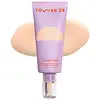Tower 28 Beauty SunnyDays Tinted SPF 30 Versus Mac Cosmetics Studio Fix Fluid SPF 15 24HR Matte Foundation + Oil Control
What's inside
What's inside
 Key Ingredients
Key Ingredients

 Benefits
Benefits

 Concerns
Concerns

 Ingredients Side-by-side
Ingredients Side-by-side

Zinc Oxide 12.6%
Cosmetic ColorantWater
Skin ConditioningIsononyl Isononanoate
EmollientC9-12 Alkane
SolventButyloctyl Salicylate
Skin ConditioningPolyglyceryl-6 Polyricinoleate
EmulsifyingCaprylic/Capric Triglyceride
MaskingGlycerin
HumectantEthylhexyl Methoxycrylene
Skin ConditioningTrimethylsiloxysilicate
EmollientMica
Cosmetic ColorantPolyglyceryl-2 Isostearate
EmulsifyingSodium Chloride
MaskingPhenoxyethanol
PreservativeDisteardimonium Hectorite
StabilisingPolyglyceryl-3 Polyricinoleate
EmulsifyingPolyhydroxystearic Acid
EmulsifyingCoco-Caprylate/Caprate
EmollientIsostearic Acid
CleansingLecithin
EmollientPolyglyceryl-6 Polyhydroxystearate
EmulsifyingJojoba Esters
EmollientEthylhexylglycerin
Skin ConditioningSodium Phytate
Aloe Barbadensis Leaf Water
MaskingCentella Asiatica Extract
CleansingOpuntia Tuna Fruit
Skin ConditioningSalvia Officinalis Extract
AntimicrobialIron Oxides
CI 77891
Cosmetic ColorantZinc Oxide 12.6%, Water, Isononyl Isononanoate, C9-12 Alkane, Butyloctyl Salicylate, Polyglyceryl-6 Polyricinoleate, Caprylic/Capric Triglyceride, Glycerin, Ethylhexyl Methoxycrylene, Trimethylsiloxysilicate, Mica, Polyglyceryl-2 Isostearate, Sodium Chloride, Phenoxyethanol, Disteardimonium Hectorite, Polyglyceryl-3 Polyricinoleate, Polyhydroxystearic Acid, Coco-Caprylate/Caprate, Isostearic Acid, Lecithin, Polyglyceryl-6 Polyhydroxystearate, Jojoba Esters, Ethylhexylglycerin, Sodium Phytate, Aloe Barbadensis Leaf Water, Centella Asiatica Extract, Opuntia Tuna Fruit, Salvia Officinalis Extract, Iron Oxides, CI 77891
Water
Skin ConditioningMethyl Trimethicone
Skin ConditioningDimethicone
EmollientTrimethylsiloxysilicate
EmollientPEG-10 Dimethicone
Skin ConditioningButylene Glycol
HumectantIsododecane
EmollientPolyethylene
AbrasiveCetyl PEG/PPG-10/1 Dimethicone
EmulsifyingMagnesium Sulfate
Algae Extract
EmollientLaminaria Saccharina Extract
Skin ProtectingSodium Hyaluronate
HumectantSalix Nigra Bark Extract
Skin ProtectingTocopheryl Acetate
AntioxidantCaffeine
Skin ConditioningLecithin
EmollientHydrogenated Lecithin
EmulsifyingDisteardimonium Hectorite
StabilisingSilica
AbrasiveXanthan Gum
EmulsifyingDimethicone Crosspolymer
Emulsion StabilisingTriethoxycaprylylsilane
Dimethicone/PEG-10/15 Crosspolymer
Methoxy Amodimethicone/Silsesquioxane Copolymer
Skin ConditioningSorbitan Sesquioleate
EmulsifyingSalicylic Acid
MaskingSodium Citrate
BufferingLaureth-7
EmulsifyingMethyldihydrojasmonate
MaskingPropylene Carbonate
SolventAlumina
AbrasiveDipropylene Glycol
HumectantPentaerythrityl Tetra-Di-T-Butyl Hydroxyhydrocinnamate
AntioxidantBHT
AntioxidantPhenoxyethanol
PreservativeSorbic Acid
PreservativeChloroxylenol
AntimicrobialCI 77891
Cosmetic ColorantCI 77491
Cosmetic ColorantCI 77492
Cosmetic ColorantCI 77499
Cosmetic ColorantWater, Methyl Trimethicone, Dimethicone, Trimethylsiloxysilicate, PEG-10 Dimethicone, Butylene Glycol, Isododecane, Polyethylene, Cetyl PEG/PPG-10/1 Dimethicone, Magnesium Sulfate, Algae Extract, Laminaria Saccharina Extract, Sodium Hyaluronate, Salix Nigra Bark Extract, Tocopheryl Acetate, Caffeine, Lecithin, Hydrogenated Lecithin, Disteardimonium Hectorite, Silica, Xanthan Gum, Dimethicone Crosspolymer, Triethoxycaprylylsilane, Dimethicone/PEG-10/15 Crosspolymer, Methoxy Amodimethicone/Silsesquioxane Copolymer, Sorbitan Sesquioleate, Salicylic Acid, Sodium Citrate, Laureth-7, Methyldihydrojasmonate, Propylene Carbonate, Alumina, Dipropylene Glycol, Pentaerythrityl Tetra-Di-T-Butyl Hydroxyhydrocinnamate, BHT, Phenoxyethanol, Sorbic Acid, Chloroxylenol, CI 77891, CI 77491, CI 77492, CI 77499
 Reviews
Reviews

Ingredients Explained
These ingredients are found in both products.
Ingredients higher up in an ingredient list are typically present in a larger amount.
Ci 77891 is a white pigment from Titanium dioxide. It is naturally found in minerals such as rutile and ilmenite.
It's main function is to add a white color to cosmetics. It can also be mixed with other colors to create different shades.
Ci 77891 is commonly found in sunscreens due to its ability to block UV rays.
Learn more about CI 77891Disteardimonium Hectorite comes from the clay mineral named hectorite. It is used to add thickness to a product.
It can also help stabilize a product by helping to disperse other ingredients.
Hectorite is a rare, white clay mineral.
Learn more about Disteardimonium HectoriteLecithin is a term for a group of substances found in the cell membranes of plants, animals, and humans. They are made up of mixture of phospholipids.
This ingredient has emollient and emulsifying properties.
As an emollient, lecithen helps soften the skin and creates a barrier to keep moisture in.
As an emulsifier, it also helps prevent water and oil ingredients from separating. Lecithin can also help ingredients be better absorbed by the skin.
This is because the phospholipids in lecithin produce liposomes. Liposomes help other ingredients get through the skin barrier.
Depending on the source of this ingredient, lecithin may not be fungal acne safe. This is because some sources of lecithin come from soybean oil, which may feed the malassezia yeast that feeds fungal acne.
We recommend reaching out to the brand you are purchasing from to inquire about the source of their lecithin.
Some other names for this ingredient include soy lecithin and deoiled soy lecithin.
Learn more about LecithinPhenoxyethanol is a preservative that has germicide, antimicrobial, and aromatic properties. Studies show that phenoxyethanol can prevent microbial growth. By itself, it has a scent that is similar to that of a rose.
It's often used in formulations along with Caprylyl Glycol to preserve the shelf life of products.
This silicone is an emollient. Emollients create a thin film on the skin to prevent moisture from escaping.
It is not soluble in water and helps increase water-resistance in products.
According to a manufacturer, it can blend seamlessly with silicone oils, such as Cyclopentasiloxane.
Learn more about TrimethylsiloxysilicateWater. It's the most common cosmetic ingredient of all. You'll usually see it at the top of ingredient lists, meaning that it makes up the largest part of the product.
So why is it so popular? Water most often acts as a solvent - this means that it helps dissolve other ingredients into the formulation.
You'll also recognize water as that liquid we all need to stay alive. If you see this, drink a glass of water. Stay hydrated!
Learn more about Water